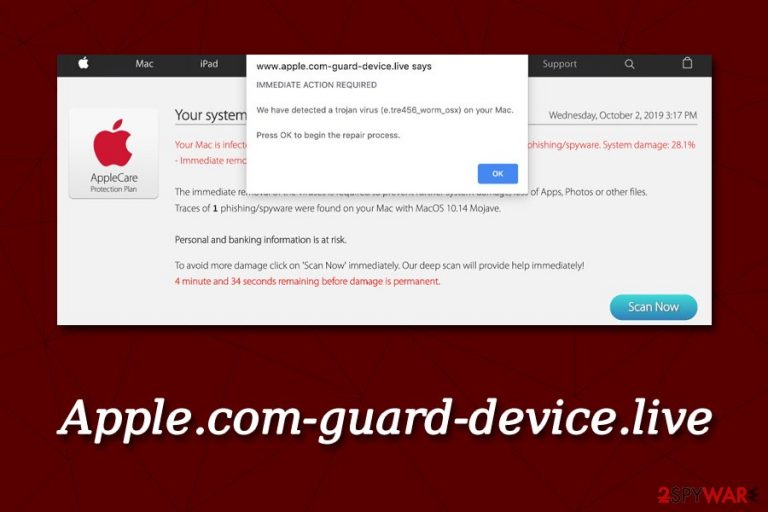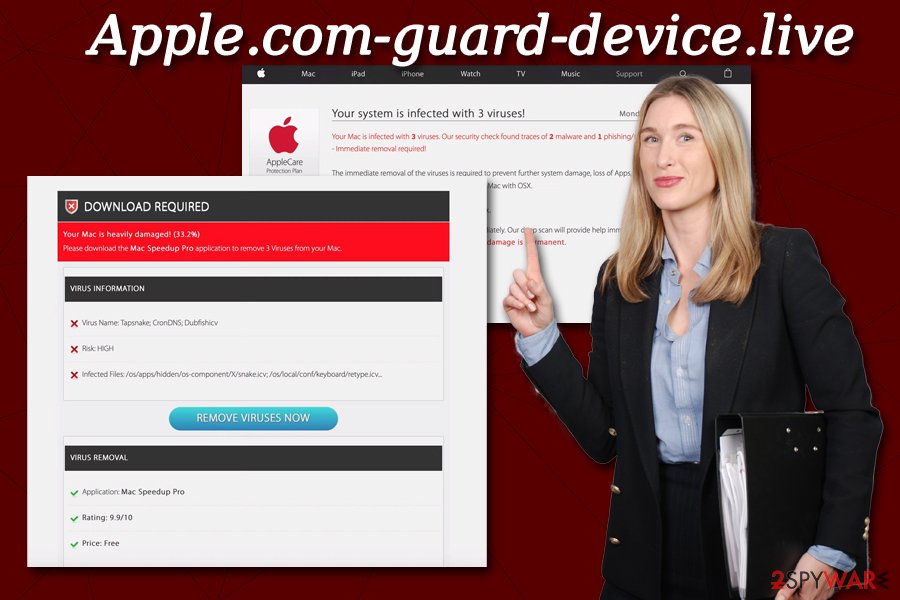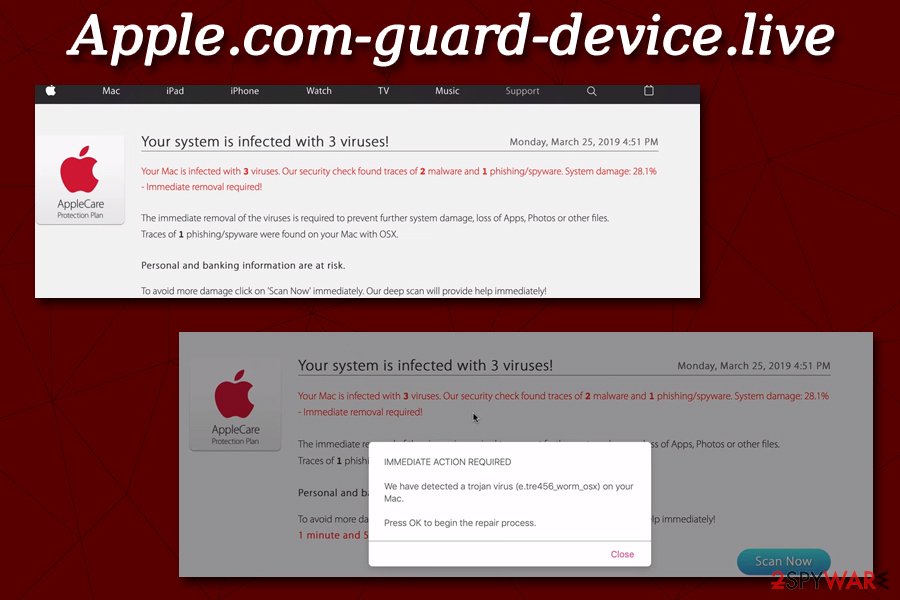Apple.com-guard-device.live (Removal Instructions) - Chrome, Firefox, IE, Edge
Apple.com-guard-device.live Removal Guide
What is Apple.com-guard-device.live?
Apple.com-guard-device.live is a fraudulent website which implies fake virus infections on macOS

Apple.com-guard-device.live is a part of a social engineering[1] attack that usually starts with an adware infection. Adware, otherwise known as ad-supported software or a potentially unwanted program, usually gets installed along with freeware/shareware applications as an optional component. Unfortunately, software developers deliberately hide PUPs during the installation process, so users install them without noticing.
Once on the system, adware changes the web browser settings of Google Chrome, Internet Explorer, Mozilla Firefox, Safari, or another browser and starts redirecting users to suspicious sites, such as Apple.com-guard-device.live. The fake alert there claims that Mac users are infected with 3 viruses and that their personal information, such as banking details, is in danger of being stolen. To allegedly remedy the situation, users are prompted to download bogus software – usually scareware[2] apps like Advanced Mac Cleaner, Mac Tonic, Super Mac Cleaner, etc.
Remember, Apple.com-guard-device.live is a scam, so you should never download anything this website suggests. All the claims are fake, although you might have to locate and uninstall adware app that has been installed behind your back in order to remove Apple.com-guard-device.live pop-ups from your browsers once and for all.
| Name | Apple.com-guard-device.live |
| Type | Fake alert, scam |
| Category | Redirects to potentially dangerous sites and frequent ads during the operation of the browser indicates adware infection |
| Scam targets | macOS/Mac OS X, iOS |
| Potential dangers | Many users who believe that scam will be tricked into downloading potentially unwanted applications that will clutter the computer and persistently demand payment for the full license, consequently resulting in money loss; adware redirects may also lead to other dangerous sites, so malware infection is also a possibility; other scam sites may ask to provide personal information that can be later used for nefarious purposes |
| Symptoms | Adware typically initiates changes to the web browsers and starts displaying intrusive ads on all sites, redirects to unknown domains, etc; those who install scareware apps might also encounter persistent pop-ups asking to upgrade, etc. |
| Termination | To stop scam pop-ups, users should check their devices for adware – use anti-malware like FortectIntego or check manual removal guide below |
The fake alert from Apple.com-guard-device.live claims the following (note that the content may vary):
IMMEDIATE ACTION REQUIRED
We have detected a trojan virus (e.tre_worm_osx) on your Mac.
Press OK to begin the repair process
Once clicked, users will shown a similar, but more detailed message, which also includes a timer. Allegedly, once it expires, the damage to the system will be permanent. At the bottom, a “Scan Now” button is located, which supposedly scans the Mac and, in the next page prompts users to install the fake optimization software.
Apple.com-guard-device.live is one of many websites used by crooks to impersonate the tech giant Apple – Apple.com-shield-guard.live, Apple.com-faster.live, Apple.com-scan-macbook.live, Apple.com-speed-macos.live, and multiple others. All of them promote the social engineering scam scheme where users are prompted to download bogus software. While these domains usually quickly shut down by reputable parties, cybercriminals reopen new ones quickly, and Apple.com-guard-device.live is one of them.
All of these scan schemes use legitimately-looking website design, often incorporating the official “AppleCare Protection Plan” logo. These elements are used in order to make inexperienced users compliant, as they are unaware that the Apple.com-guard-device.live pop-up message is coming from cybercrooks rather than Apple.

Just to be clear, Apple.com-guard-device.live prompt shows up within the browser, and viruses simply cannot be detected remotely like that. To confirm malware infections, there must be a dedicated application installed on the Mac computer. Therefore, all claims about virus infections, cyber spying, and similar are fake, so your should always ignore them.
Nevertheless, Apple.com-guard-device.live removal from your browsers might require some additional work – if you are infected with adware, that is. For a quick solution, scan your Mac with anti-malware software like FortectIntego or check the list of the installed for unwanted programs manually.
Practice safe browsing habits when using the internet
When it comes to Mac operating systems, users are always notified that an application from a third-party site is about to be installed, and they asked to enter their Apple ID to confirm. Therefore, most infection of adware happen when downloading apps from third-party sites intentionally. While, esentially, there is nothing wrong with that, users should be aware that it comes with certain risks.
For example, most of the third-party sites distribute bundled software. Therefore, if the installation process is not looked at carefully, there is a high chance that option application will be installed without users' notice. To avoid that, you should always check every installation step carefully:
- decline all the deals/offers;
- read the text in fine print;
- de-select pre-ticked boxes;
- choose Advanced/Custom settings instead of Recommended/Quick at all times.
Of course, seeing how App Store has almost 4 million apps,[3] there is plenty to choose from, and if an alternative to that program you found somewhere exists, always pick the official source instead.

Get rid of fake notifications from Apple.com-guard-device.live
To remove Apple.com-guard-device.live pop-ups, as well as redirects to suspicious sites, you need to locate adware on your Mac and uninstall it. However, in some cases, it might be just more difficult than it might seem. While moving the Application to Trash works well for most legitimate apps, potentially unwanted programs often use various techniques to remain on the host machine as long as possible. For example, Apple.com-guard-device.live virus may leave traces in /Library/LaunchAgents, /Library/Application Support, /Library/LaunchDaemons folders, and also create a new profile. Thus, make sure you check these places when you are eliminating PUPs manually.
Instead of wasting your time, you can also opt for automatic Apple.com-guard-device.live removal with the help of anti-malware software that specializes in potentially unwanted programs. Simply download a security tool and perform a full system scan – this way, you will avoid looking for adware traces scattered on your macOS.
You may remove virus damage with a help of FortectIntego. SpyHunter 5Combo Cleaner and Malwarebytes are recommended to detect potentially unwanted programs and viruses with all their files and registry entries that are related to them.
Getting rid of Apple.com-guard-device.live. Follow these steps
Delete from macOS
To get rid of adware on your Mac, please follow these instructions:
Remove items from Applications folder:
- From the menu bar, select Go > Applications.
- In the Applications folder, look for all related entries.
- Click on the app and drag it to Trash (or right-click and pick Move to Trash)

To fully remove an unwanted app, you need to access Application Support, LaunchAgents, and LaunchDaemons folders and delete relevant files:
- Select Go > Go to Folder.
- Enter /Library/Application Support and click Go or press Enter.
- In the Application Support folder, look for any dubious entries and then delete them.
- Now enter /Library/LaunchAgents and /Library/LaunchDaemons folders the same way and terminate all the related .plist files.

Remove from Microsoft Edge
Delete unwanted extensions from MS Edge:
- Select Menu (three horizontal dots at the top-right of the browser window) and pick Extensions.
- From the list, pick the extension and click on the Gear icon.
- Click on Uninstall at the bottom.

Clear cookies and other browser data:
- Click on the Menu (three horizontal dots at the top-right of the browser window) and select Privacy & security.
- Under Clear browsing data, pick Choose what to clear.
- Select everything (apart from passwords, although you might want to include Media licenses as well, if applicable) and click on Clear.

Restore new tab and homepage settings:
- Click the menu icon and choose Settings.
- Then find On startup section.
- Click Disable if you found any suspicious domain.
Reset MS Edge if the above steps did not work:
- Press on Ctrl + Shift + Esc to open Task Manager.
- Click on More details arrow at the bottom of the window.
- Select Details tab.
- Now scroll down and locate every entry with Microsoft Edge name in it. Right-click on each of them and select End Task to stop MS Edge from running.

If this solution failed to help you, you need to use an advanced Edge reset method. Note that you need to backup your data before proceeding.
- Find the following folder on your computer: C:\\Users\\%username%\\AppData\\Local\\Packages\\Microsoft.MicrosoftEdge_8wekyb3d8bbwe.
- Press Ctrl + A on your keyboard to select all folders.
- Right-click on them and pick Delete

- Now right-click on the Start button and pick Windows PowerShell (Admin).
- When the new window opens, copy and paste the following command, and then press Enter:
Get-AppXPackage -AllUsers -Name Microsoft.MicrosoftEdge | Foreach {Add-AppxPackage -DisableDevelopmentMode -Register “$($_.InstallLocation)\\AppXManifest.xml” -Verbose

Instructions for Chromium-based Edge
Delete extensions from MS Edge (Chromium):
- Open Edge and click select Settings > Extensions.
- Delete unwanted extensions by clicking Remove.

Clear cache and site data:
- Click on Menu and go to Settings.
- Select Privacy, search and services.
- Under Clear browsing data, pick Choose what to clear.
- Under Time range, pick All time.
- Select Clear now.

Reset Chromium-based MS Edge:
- Click on Menu and select Settings.
- On the left side, pick Reset settings.
- Select Restore settings to their default values.
- Confirm with Reset.

Remove from Mozilla Firefox (FF)
After you eliminate the root app that initiated Apple.com-guard-device.live pop-ups; it is also advisable to reset Mozilla Firefox to make sure the suspicious activity does not continue:
Remove dangerous extensions:
- Open Mozilla Firefox browser and click on the Menu (three horizontal lines at the top-right of the window).
- Select Add-ons.
- In here, select unwanted plugin and click Remove.

Reset the homepage:
- Click three horizontal lines at the top right corner to open the menu.
- Choose Options.
- Under Home options, enter your preferred site that will open every time you newly open the Mozilla Firefox.
Clear cookies and site data:
- Click Menu and pick Settings.
- Go to Privacy & Security section.
- Scroll down to locate Cookies and Site Data.
- Click on Clear Data…
- Select Cookies and Site Data, as well as Cached Web Content and press Clear.

Reset Mozilla Firefox
If clearing the browser as explained above did not help, reset Mozilla Firefox:
- Open Mozilla Firefox browser and click the Menu.
- Go to Help and then choose Troubleshooting Information.

- Under Give Firefox a tune up section, click on Refresh Firefox…
- Once the pop-up shows up, confirm the action by pressing on Refresh Firefox.

Remove from Google Chrome
To reset Google Chrome and stop unwanted ads and redirects, follow this guide:
Delete malicious extensions from Google Chrome:
- Open Google Chrome, click on the Menu (three vertical dots at the top-right corner) and select More tools > Extensions.
- In the newly opened window, you will see all the installed extensions. Uninstall all the suspicious plugins that might be related to the unwanted program by clicking Remove.

Clear cache and web data from Chrome:
- Click on Menu and pick Settings.
- Under Privacy and security, select Clear browsing data.
- Select Browsing history, Cookies and other site data, as well as Cached images and files.
- Click Clear data.

Change your homepage:
- Click menu and choose Settings.
- Look for a suspicious site in the On startup section.
- Click on Open a specific or set of pages and click on three dots to find the Remove option.
Reset Google Chrome:
If the previous methods did not help you, reset Google Chrome to eliminate all the unwanted components:
- Click on Menu and select Settings.
- In the Settings, scroll down and click Advanced.
- Scroll down and locate Reset and clean up section.
- Now click Restore settings to their original defaults.
- Confirm with Reset settings.

Delete from Safari
Remove unwanted extensions from Safari:
- Click Safari > Preferences…
- In the new window, pick Extensions.
- Select the unwanted extension and select Uninstall.

Clear cookies and other website data from Safari:
- Click Safari > Clear History…
- From the drop-down menu under Clear, pick all history.
- Confirm with Clear History.

Reset Safari if the above-mentioned steps did not help you:
- Click Safari > Preferences…
- Go to Advanced tab.
- Tick the Show Develop menu in menu bar.
- From the menu bar, click Develop, and then select Empty Caches.

After uninstalling this potentially unwanted program (PUP) and fixing each of your web browsers, we recommend you to scan your PC system with a reputable anti-spyware. This will help you to get rid of Apple.com-guard-device.live registry traces and will also identify related parasites or possible malware infections on your computer. For that you can use our top-rated malware remover: FortectIntego, SpyHunter 5Combo Cleaner or Malwarebytes.
How to prevent from getting adware
Stream videos without limitations, no matter where you are
There are multiple parties that could find out almost anything about you by checking your online activity. While this is highly unlikely, advertisers and tech companies are constantly tracking you online. The first step to privacy should be a secure browser that focuses on tracker reduction to a minimum.
Even if you employ a secure browser, you will not be able to access websites that are restricted due to local government laws or other reasons. In other words, you may not be able to stream Disney+ or US-based Netflix in some countries. To bypass these restrictions, you can employ a powerful Private Internet Access VPN, which provides dedicated servers for torrenting and streaming, not slowing you down in the process.
Data backups are important – recover your lost files
Ransomware is one of the biggest threats to personal data. Once it is executed on a machine, it launches a sophisticated encryption algorithm that locks all your files, although it does not destroy them. The most common misconception is that anti-malware software can return files to their previous states. This is not true, however, and data remains locked after the malicious payload is deleted.
While regular data backups are the only secure method to recover your files after a ransomware attack, tools such as Data Recovery Pro can also be effective and restore at least some of your lost data.
- ^ Social engineering (security). Wikipedia. The free encyclopedia.
- ^ What is Scareware?. Forcepoint. Human-Centric Cybersecurity.
- ^ Number of available apps in the Apple App Store from 2008 to 2019 (in 1,000s). Statista. Statistics portal.
